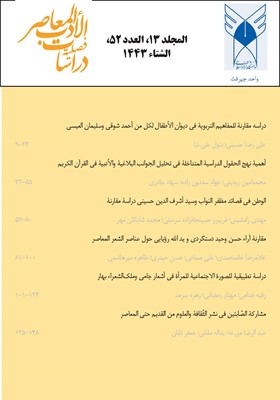دراسه مقارنة للمفاهیم التربوية فی ديوان الأطفال لكل من أحمد شوقی وسليمان العیسی
محورهای موضوعی : Contemporary Literature Studiesعلی رضا حسینی 1 * , بتول علی نیا 2
1 - أستاذ مساعد في اللغة العربية وآدابها جامعة كوثر بجنورد
2 - أستاذة مساعدة، قسم اللغة العربية وآدابها، فرع إسلام شهر، جامعة آزاد الإسلامية، إسلام شهر، إيران
کلید واژه: دیوان الأطفال, سلیمان العیسی, التعليم, أدب الأطفال, أحمد شوقي,
چکیده مقاله :
في إطار الأدب المقارن، يسعی هذا البحث إلی مقارنة وشرح بعض المفاهيم التربوية الشائعة في ديوان الأطفال لكل من أحمد شوقي وسليمان العيسی من خلال دراسة قصائدهما. وبما أن أدب الأطفال يعد من الجوانب المهمة في أدب أي شعب وبلد، لذلك من الأهمية بمكان معالجته؛ وهنا تتبادر هذه الأسئلة إلی الذهن: ما هي المفاهيم التربوية المشتركة في ديوان الأطفال لأحمد شوقي وسليمان عيسی، وما هو سبب الاختلافات المفهومية في قصائد الشاعرين؟ تتمثل فرضيتنا في أن كلا الشاعرين تأثرا بمجتمعهما، وأن الآثار التربوية المشتركة لقصائدهما تنبع من الاهتمامات المقترنة بتربية الأطفال. بسبب الأسبقية الزمنية لأحمد شوقي وتأثره الأكبر بالثقافة الغربية، ونظراً لتأثر سليمان العيسی بالتيارات الأدبية الجديدة والأحداث السياسية في عصره، فقد تعامل كل منهما مع موضوع التربية الأخلاقية والاجتماعية. تظهر نتائج البحث أن كلاً من الشاعرين قد أولی في قلب ومحتوی قصائده اهتماماً كبيراً بالمفاهيم التربوية التي تعتبر قيّمة من كل النواحي. وهكذا، وعلی الرغم من الاختلافات، يمكننا اعتبار المفاهيم المشتركة بينهما علی أنها الاهتمام بالقيم الأخلاقية والاجتماعية، والحرية، والوطنية، والاستقلال عن الاستعمار الأجنبي.
The present research is carried out in the comparative literature framework and intends to compare some of the common educational concepts in children's diwan of Ahmad Showghi and Suleiman Al-Issa in comparative literature the framework by relying on their poems; since children's literature is one of the significant sections in the literature of any nation, so it is important to address it. In this research, these questions are answered: What are the common educational concepts in the children's diwan of two poets and also what is the reason for the conceptual differences between the poems of the two poets? Both poets seem to have been influenced by their society, and therefore the common meanings of their poems stem from their concerns. Suleiman al-Issa also deals with the influence of new literary currents on the subject of entertainment, while Showghi pays attention to the details of moral education. The results show that both poets pay attention to educational concepts and in addition to the conceptual differences in their poems, we can point to the common concepts of their poetries such as moral and social values, freedom, patriotism and independence.
ابومعال، عبدالفتاح. 1988م، أدب الأطفال، الطبعة الثانیة، عمان- الأردن: دار الشروق للنشر والتوزیع.
بروکلمان، کارل. 1977م، تاریخ الأدب العربی، القاهرة: دار المعارف.
بقاعي، إیمان یوسف. 1994م، سلیمان العیسی منشد العروبة والأطفال، الطبعة الأولی، بیروت: دار الکتب العلمیة.
زلط، احمد. 1998م، أدب الطفل العربی، الطبعة الأولی، دار هبة النیل للنشر والتوزیع.
شوقي، احمد. 1992م، الشوقيات، 2مجلد، بیروت: دار الکتاب العربی.
عمر، فروخ. 1950م، تاریخ الأدب العربی، القاهرة: الهیئة المصریة العامة للکتاب.
عمر، فروخ. 1969م، تاریخ الأدب العربی، القاهرة: الهیئة المصریة العامة للکتاب.
العیسی، سلیمان. 2005م، دیوان الأطفال، بیروت: دار النهضة.
العیسی، سلیمان. 2013م، دیوان شعر، بیروت: مکتبة نور.
الفاخوری، حنا. 1998م ، تاریخ الأدب العربی، الطبعة الثامنة، بیروت: المکتبة البولیسیة.
کنعان، احمد. 1995م، أدب الأطفال والقيم التربوية، دمشق: دار الفكر.
ناصیف، علی النجدی. 1948م، الدین والأخلاق فی شعر شوقي، القاهرة: مطبعة کوستا.
المقالات والرسائل الجامعیة
الأرناؤوط، عبداللطیف. 1996م، «تجربة شاعر سلیمان العیسی في کتابه أناشید الأطفال»، مجلة الموقف الأدبي، العدد302.
باوانپوری، مسعود و همکاران. 1393ش، «نگاهی به ادبیات کودک در سرزمینهای عربی مطالعه مورد پژوهانه سلیمان العیسی»، همایش ملی رویکردهای کاربردی و پژوهشی در علوم انسانی و مدیریت.
علی نیا، بتول. 1383ش، «ادبیات کودکان در زبان عربی»، پژوهش برای دانشگاه آزاد اسلامی واحد اسلامشهر، در رشته زبان و ادبیات عرب.
وزیری مهر، سهیلا و مصطفی سالاری و بهروز رومیانی. 1398ش، «التحلیل الأدبی عن القصص الخیالیة فی الآثار المختارة من الأربعینیات وتأثیرها فی أدب الطفل الإیرانی»، دراسات الأدب المعاصر، السنة الحادیة عشرة، العدد الواحد والأربعون.
_||_
Abu Maal, Abdel Fattah. 1988, Children's Literature, second edition, Amman - Jordan: Dar Al-Shorouk for Publishing and Distribution.
Brockelmann, Carl. 1977, History of Arabic Literature, Cairo: Dar Al Maaref.
Bukai, Iman Youssef. 1994, Suleiman Al-Issa, the singer of Arabism and children, first edition, Beirut: Dar Al-Kutub Al-Ilmiyya.
Zalat, Ahmed. 1998, Arabic Children's Literature, first edition, Heba El-Nil House for Publishing and Distribution.
Shawqi, Ahmed. 1992, Al-Shawqiyat, Beirut: Dar Al-Kitab Al-Arabi.
Omar, Farrukh. 1950, History of Arabic Literature, Cairo: The Egyptian General Book Organization.
Omar, Farrukh. 1969, History of Arabic Literature, Cairo: The Egyptian General Book Organization.
Al-Issa, Suleiman. 2005, Children's Diwan, Beirut: Dar Al-Nahda.
Al-Issa, Suleiman. 2013, Diwan of Poetry, Beirut: Nour Library.
Fakhoury, Hanna. 1998, History of Arabic Literature, eighth edition, Beirut: Police Library.
Kanaan, Ahmed. 1995, Children's Literature and Educational Values, Damascus: Dar Al-Fikr.
Nassif, Ali Al-Najdi. 1948, Religion and Ethics in Shawqi's Poetry, Cairo: Costa Press.
University Articles and Theses:
Arnaout, Abdul Latif. 1996, “The Experience of the Poet of Suleiman Al-Issa in Writing Children’s Songs,” Literary Position Magazine, No. 302.
Bavanapuri, Massoud et al. 2014, "A look at children's literature in the Arab lands, the case study of Suleiman al-Issa", National Conference on Applied and Research Approaches in Humanities and Management.
Ali Nia, Batool. 2004, "Children's Literature in Arabic", A Research for the Islamic Azad University, Islamshahr Branch, in the field of Arabic language and literature.
Vaziri Mehr, Soheila and Mostafa Salari and Behrooz Romiani. 1398, "Literary analysis of imaginary stories in the works of the four-dimensional works and their effects on the literature of the Iranian child", the lessons of contemporary literature, the tenth Sunni tradition, the number one and the four.

